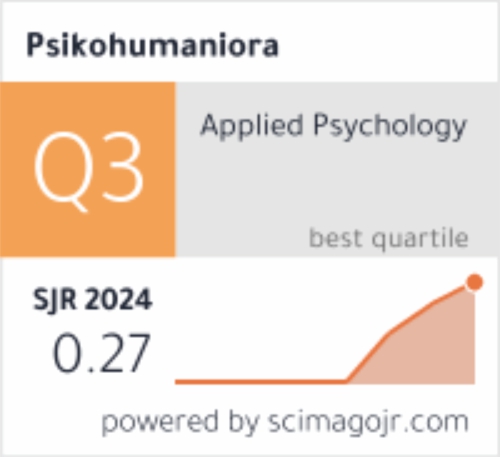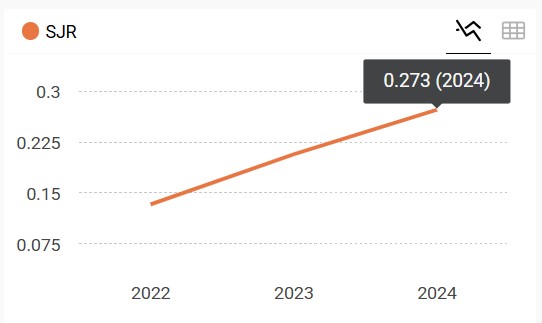Student Well-being pada Remaja Jawa
DOI:
https://doi.org/10.21580/pjpp.v2i1.979Keywords:
student well-being, adolescence, JavaAbstract
Abstract: This study aims to describe the source of student well-being in Javanese adolescents. This research uses quantitative research approach and supported by qualitative. Research location in Banyumas with cluster random sampling technique. Instrument data collection using the scale of student well-being and open source questionaire student well-being and interview guide. Quantitative data analysis using descriptive. The results of the study are: 1) The sources of student well-being are the dimensions of social relations, cognitive, emotional and spiritual. 2) The inhibiting factor of achieving student well-being is if there are problems in the social, cognitive, emotional, physical and spiritual.
Abstrak: Penelitian ini bertujuan untuk mendeskripsikan sumber student well-being pada remaja Jawa. Penelitian ini menggunakan pendekatan penelitian kuantitatif dan didukung dengan kualitatif. Lokasi penelitian di Banyumas dengan teknik cluster random sampling. Instrumen pengumpulan data menggunakan skala student well-being dan openquesioner sumber student well-being serta panduan wawancara. Analisis data kuantitatif menggunakan deskriptif. Hasil penelitian adalah: 1) Sumber-sumber student well-being adalah dimensi hubungan sosial, kognitif, emosi dan spiritual. 2) Faktor penghambat tercapainya student well-being adalah jika ada masalah dalam dimensi sosial, kognitif, emosi, fisik dan spiritual.
Downloads
References
Amato, P. R. (1994). Father-child relations, mother-child relations, and offspring psychological well-being in early adulthood. Journal of Marriage and Family, 56(4), 1031–1042. https://doi.org/10.2307/353611
Australian Catholic University. (2008). Scoping Study into Approaches to Student Well-being: Final Report (Report to the Department of Education Employment and Workplace Relations).
Awartani, M., Whitman, C. V., & Gordon, J. (2008). Developing instruments to capture young people’s perceptions of how school as a learning environment affects their well-being. European Journal of Education, 43(1), 51–70. https://doi.org/10.1111/ j.1465-3435.2007.00337.x
Ben-Zur, H. (2003). Happy adolescents: the link between subjective well-being, internal resources, and parental factors. Journal of Youth and Adolescence, 32(2), 67–79. https://doi.org/10.1023/A:1021864432505
Ciochinã, L., & Faria, L. (2009). Individualism and collectivism: What differences between Portuguese and Romanian adolescents? The Spanish Journal of Psychology, 12(2), 555–564. https://doi.org/10.1017/S113874160000192X
Compton, W. C. (2005). Introduction to positive psychology. USA: Thomson Learning.
Eccles, J. S. (1999). The development of children ages 6 to 14. The Future of Children, 9(2), 30–44. https://doi.org/10.2307/1602703
Endraswara, S. (2006). Metode, Teori, teknik, penelitian kebudayaan: Ideologi, epistemologi dan aplikasi. Yogyakarta: Pustaka Widyatama.
Fraillon, J. (2004). Measuring student well-being in the context of Australian schooling: Discussion paper. The Australian Council for Educational Research, (2), 1–54.
Fraine, B. D., Landeghem, G. V., Damme, J. V., & Onghena, P. (2005). An analysis of well-being in secondary school with multilevel growth curve models and multilevel multivariate models. Quality and Quantity, 39(3), 297–316. https://doi.org/ 10.1007/s11135-004-5010-1
Frost, P., & Smith, R. (2010). The effectiveness of student well-being programs and services. Melbourne: Victorian General Report.
Gilman, R., & Huebner, E. S. (2006). Characteristics of adolescents who report very high life satisfaction. Journal of Youth and Adolescence, 35(3), 293–301. https:// doi.org/10.1007/s10964-006-9036-7
Herusatoto, B. (2008). Simbolisme Jawa. Yogyakarta: Ombak.
Jaafar, J. L., Idris, M. A., Ismuni, J., Fei, Y., Jaafar, S., Ahmad, Z., Sugandi, Y. S. (2012). The sources of happiness to the Malaysians and Indonesians: Data from a Smaller Nation. Procedia - Social and Behavioral Sciences, 65(Supplement C), 549–556. https:// doi.org/10.1016/j.sbspro.2012.11.164
Karyani, U., Prihartanti, N., Dinar, W., Lestari, R., Hertinjung, W. S., Prasetyaningrum, J., & Yuwono, Y. (2015). The dimensions of student well-being. In Seminar Psikologi & Kemanusiaan, Psychology Forum UMM.
Muhammad, M. (2009). Aspek Perlindungan anak dalam tindak kekerasan (bullying) terhadap siswa korban kekerasan di sekolah: Studi kasus di SMK Kabupaten Banyumas. Jurnal Dinamika Hukum, 9(3), 230–236. https://doi.org/10.20884/ 1.jdh.2009.9.3.234
Myers, J. E., Sweeney, T. J., & Witmer, J. M. (2000). The wheel of wellness counseling for wellness: A holistic model for treatment planning. Journal of Counseling & Development, 78(3), 251–266. https://doi.org/10.1002/j.1556-6676.2000.tb01906.x
Na’imah, T. (2010). Studi tentang strategi wanita dalam pengembangan karakter anak dari keluarga miskin di Purwokerto Selatan. Psychoidea, 8(1), 53–71.
Na’imah, T., & Dwiyanti, R. (2015). The implications of school well-being model as Banyumasan character strengthening for students in kindergarten. Asia Pacific Journal of Research, 1(30), 55–61.
Piko, B. F., & Hamvai, C. (2010). Parent, school and peer-related correlates of adolescents’ life satisfaction. Children and Youth Services Review, 32(10), 1479–1482. https://doi.org/ 10.1016/j.childyouth.2010.07.007
Pollard, E. L., & Lee, P. D. (2003). Child well-being: a systematic review of the literature. Social Indicators Research, 61(1), 59–78. https://doi.org/10.1023/A:1021284215801
Riauskina, I. I., Djuwita, R., & Soesetio, S. R. (2005). “Gencet-gencetan” di mata siswa/siswi kelas 1 SMA: Naskah kognitif tentang arti, skenario, dan dampak "gencet-gencetan”. Jurnal Psikologi Sosial, 12(1), 1–15.
Rickwood, R. R. (2002). Enabling high-risk clients: Exploring a career resiliency model. Diambil dari www.contactpoint.ca/natcon-conat/2002 /pdf/pdf-02-10.pdf
Ryff, C. D., & Keyes, C. L. M. (1995). The structure of psychological well-being revisited. Journal of Personality and Social Psychology, 69(4), 719–727.
Santrock, J. W. (2012). Life-span development (13 ed.). University of Texas, Dallas: McGraw-Hill.
Suseno, F. M. (2003). Etika Jawa Sebuah analisa falsafah tentang kebijaksanaan hidup Jawa (9 ed.). Jakarta: Gramedia Pustaka Utama.
Victorian General Report. (2010). The effectiveness of student well-being programs and services.
Wijayanti, H., & Nurwianti, F. (2011). Kekuatan karakter dan kebahagiaan pada suku Jawa. Jurnal Ilmiah Psikologi, 3(2), 114–122.
Wilkinson, R. B. (2004). The role of parental and peer attachment in the psychological health and self-esteem of adolescents. Journal of Youth and Adolescence, 33(6), 479–493. https://doi.org/10.1023/B:JOYO.0000048063.59425.20
Downloads
Published
How to Cite
Issue
Section
License
The copyright of the accepted article shall be assigned to the publisher of the journal. The intended copyright includes the right to publish the article in various forms (including reprints). The journal maintains the publishing rights to published articles.
In line with the license, authors and any users (readers and other researchers) are allowed to share and adapt the material only for non-commercial purposes. In addition, the material must be given appropriate credit, provided with a link to the license, and indicated if changes were made. If authors remix, transform, or build upon the material, authors must distribute their contributions under the same license as the original.




